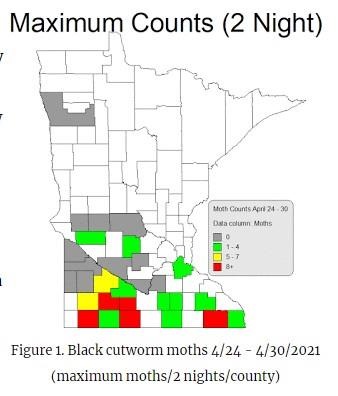By Bruce Potter
Black cutworm (BCW) moth arrivals into Minnesota increased during the week of April 24 to 30. Southerly wind flows from April 26 to 28 brought moths to southern Minnesota and particularly to an area in SW and SC Minnesota. The area where moth captures were large enough to indicate the potential for damage from larvae (nine or more moths/2 nights) includes Nobles, Cottonwood, Watonwan, Martin, and neighboring counties. Fillmore County also had a significant capture (Figure 1).

Migrating BCW often drop out on the backside of thunderstorms and the locations of this spring’s moth captures are as variable as rainfall. Moth migration further into the northwest part of the state has been blocked by high pressure.
Note which fields had not been tilled and planted by April 26. This is one of several clues you will be able to use help focus scouting efforts for black cutworms in a few weeks.
Based on historical average temperatures, the eggs laid by moths from this flight(s) should begin to hatch around May 6 and the resultant larvae will be large enough to cut small corn plants by May 26.
During this spring, results of the 2021 trap network captures and predictions of BCW cutting will be posted weekly at: https://z.umn.edu/bcw-reporting. There will be additional alerts for any BCW high-risk areas picked up by the network.
Source : umn.edu